USA Real Estate Value Reaching New Highs
The American housing market is experiencing a historic resurgence, breaking records, and surpassing expectations.
Whether you’re a real estate agent, investor, or simply interested in the market, staying up to date with real estate developments is crucial for making informed decisions.
With a total value of $52 trillion, residential real estate in the United States has climbed 49% higher than pre-pandemic levels. In this blog, we’ll explore the factors contributing to this remarkable growth, the regional dynamics at play, and what it all means for homeowners, buyers, and the industry as a whole.
The Leading Markets
New York, Los Angeles, San Francisco, Boston, and Miami are the most valuable housing markets in the country. Florida has surged ahead, overtaking New York to claim the second-most-valuable real estate market, with California retaining its top spot.
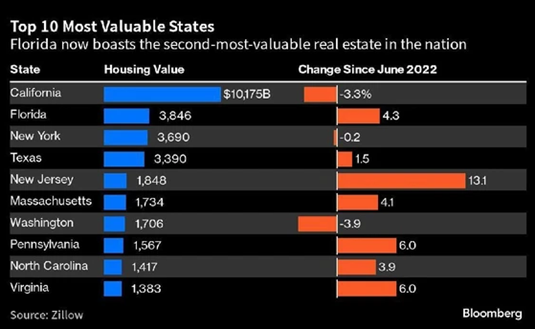
Low levels of supply coupled with high-rate mortgages have left current homeowners reluctant to give up their low-cost loans, which has pushed nationwide prices to a new high.
The total value of United States housing rose more than $2.6 trillion in the past year and have challenged predictions that higher borrowing costs would lead to a prolonged decline.
California represents 1/5 of the nation’s housing market where prices have luckily declined since June 2022, showing an optimistic outlook for nationwide real estate value. However, the gains have not been evenly spread around the country, as those leaving the golden state are relocating elsewhere in the US.
The value of residential property in Florida has risen $160 billion in the same 16-month time period pushing the state ahead of New York in the national rankings.
Home Prices
The U.S. housing market experienced a brief setback from July 2022 to January 2023 due to higher mortgage rates. This led potential buyers to reconsider their plans, causing residential investments to dip.
This downturn was short-lived, as the market rebounded impressively in 2023. Home prices are expected to continue to rise into 2024 because homes are not being built fast enough to keep up with the demand which is putting upward pressure on prices.
Aside from a 42% home price increase in the US between January 2020 – June 2023, many homes on the market still receive multiple offers and the National Association of Realtors expect home prices to rise by 2.6% in 2024.
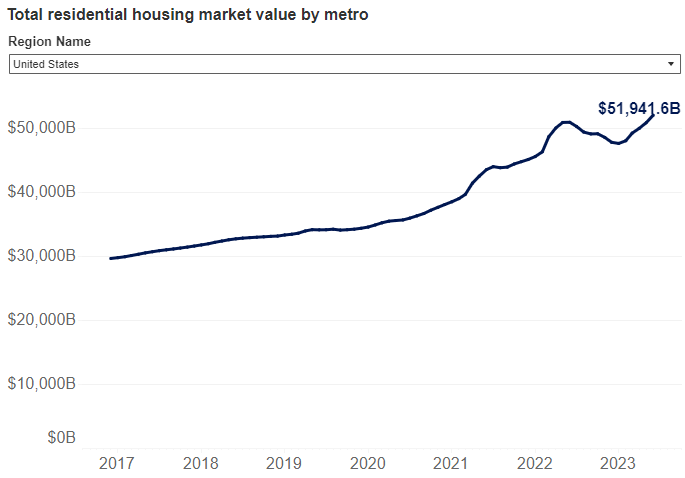
Many potential buyers were priced out of the market after 30-year mortgage rates almost doubled, which cooled the real estate market a bit. Between July 2022 and January 2023, the median home price in the US declined by 2.5%.
Supply and demand are the push and pull factors that determine the strength of the market. Demand for housing is climbing, however existing home sales are down.
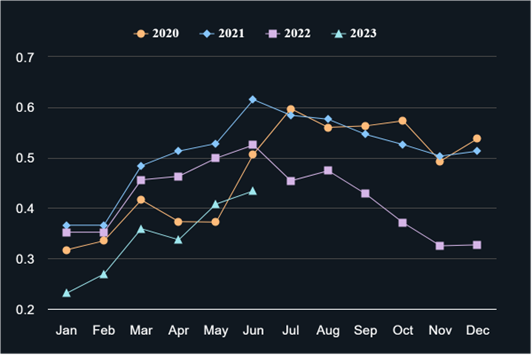
The chart above reveals existing home sales remain lower than levels seen in previous years. The explanation is an imbalance between demand and supply. Following the financial crisis of 2008, the US has seen an annual increase of about 1.2 million new households.
In contrast, the addition of new homes has been trailing at approximately 1.1 million units per year. Additionally, 200,000 homes are removed from the market annually due to alternative usage, resulting in an annual shortage of about 300,000 housing units to meet the demand over the past 15 years.
The home prices in the United States reflect the tight housing stock so far in 2023. With reduced stock putting upward pressure on prices, sellers are in luck during this time. Unfortunately for buyers, it doesn’t help those who already feel like they are priced out of purchasing a home.
The Engine Behind the Surge – New Construction
A small part of this growth can be attributed to a 1.3% rise in the average value of a U.S. home over the past year (September 2022-2023), where the real powerhouse behind this surge is new construction.
Builders have been hard at work, addressing the housing deficit by introducing a steady stream of new homes to the market this spring and summer.
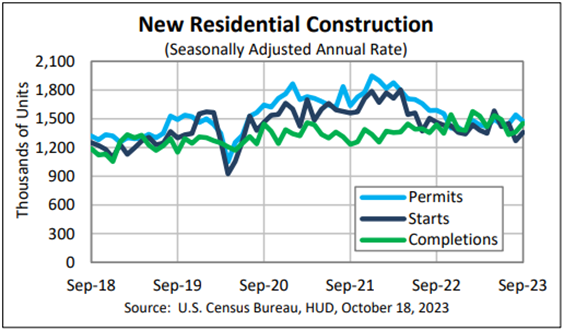
New residential construction statistics in September 2023 show a gradual catch up in the completion of homes compared to the permits and housing starts.
Single-family authorizations in September were at a rate of 965,000; this is 1.8 % above the revised August figure of 948,000. Authorizations of units in buildings with five units or more were 459,000 in September.
Single-family housing starts were up 3.2% since August 2023, jumping from 933,00 in August to 963,000 in September. Finally, Housing completions of Single-Family units in September was 998,000, a 5.3% increase from August’s rate of 948,000.
With many homeowners opting to keep their low mortgage rates, new home sales are going to play a larger role in the housing market. Homebuilders do not have the luxury of outwaiting the market; as a result, they need to sell their homes no matter the market conditions.
Builders have also adapted to the changing landscape, offering smaller, more affordable homes, and enticing buyers with incentives like interest rate buydowns. Tightening credit conditions, however, have made it harder for builders to access funding for new projects.
Additionally, the wave of new construction has caused hard money lenders to pull back. Luckily, Asset Based Lending understands how the market trends have made it more difficult for developers to obtain loans, and we can offer quick access to capital for new construction projects.
We fund single-family, multi-family, and mixed-use properties for new construction that can be approved in hours and close in days.
Overcoming Obstacles
To continue this positive trajectory, builders have embraced higher-density housing wherever possible to counter increased costs and provide much-needed housing units.
However, obstacles to new construction remain in many parts of the country. Policies that promote increased density and expand buildable land could be helpful in addressing these challenges.
Local governments in 2023 have strict zoning laws and regulatory barriers that can make it hard for developers to build, especially lower-cost, high-density housing. If more communities would allow for small multi-family housing or even single-family houses on smaller lots, then the U.S. might see more of that type of inventory getting built.
Stable Top Five
Over the past five years, the list of the most valuable metro areas has remained consistent, with New York, Los Angeles, San Francisco, and Boston taking the top four spots.
A new contender, Miami, has risen to claim the fifth spot, displacing Washington, D.C.

It is no surprise that cities offer a variety of employment opportunities along with a lot of culture, sports, dining, etc. that makes the desire to live in these metros so expensive.
Urban living often comes with a high price tag. According to the Council for Community and Economic Research, the list of the top 10 most costly cities in the first quarter of 2022 included two boroughs of New York City and four cities in California.
In these places, median incomes tend to be notably lower in comparison to the expenses associated with housing, groceries, gas, and taxes. The collective cost of living in these 5 cities exceeds the national average by a substantial margin, amounting to at least 49% higher expenses.
Florida’s Remarkable Rise
Florida has become a standout success story, with four of the top six markets that gained the most value since the pandemic’s onset located within the Sunshine State. Tampa, Miami, Jacksonville, and Orlando have seen significant growth in their housing markets.
Rising home values are attributed to substantial population growth and increased competition for existing homes. These factors have propelled Florida to become the state with the second-most valuable housing market.
Anticipated to contribute significantly to the demand, new home sales are projected to rise, as many current homeowners opt to stay put. This choice is driven by the challenge of locating available housing inventory and the hesitancy to give up favorable mortgage rates, especially when unable to make an all-cash purchase.
As the surge in home values persists, three additional Florida real estate markets, apart from Miami, have witnessed a substantial increase in housing values during this period.
Since September 2022, Tampa observed an impressive 88.9% market increase, Jacksonville saw an 82.4% rise, and Orlando experienced a 72.3% climb.
When combined with Miami, Florida has become the state with the second most valuable housing market, surpassing New York but still trailing behind California.
California: A Behemoth of Real Estate
With a total value of over $10 trillion, California represents nearly 20% of the national total housing market. Homes in California are now, in 2023, even more expensive than they were one year ago. According to data from the California Association of Realtors, existing single-family homes sold for a median of $859,800 in August 2023, compared to $834,740 in August 2022.
That’s a 3 percent increase, and it’s more than double the national median of $407,100. Today’s significantly higher interest rates make that price feel even less affordable for the average homebuyer.
Typically, sellers hold a strong advantage in real estate transactions in this area. The demand for properties is robust, while the available supply is extremely limited, amounting to only a two-month inventory, as reported by Redfin. This falls short of the five to six months typically required for a balanced market.
However, investors attempting to sell their California residences might face challenges navigating the elevated mortgage rates such as locating buyers with the financial capacity to make the purchase.
If these rates persist in their upward trend, sellers might need to adjust their expectations and consider accepting lower offers to navigate this challenging real estate landscape.
In Review
The U.S. real estate market is constantly shifting, now more than ever. Marked by record-breaking achievements and rising home values in 2023, staying informed about these trends is crucial for anyone involved in real estate.
Both California and Florida have played pivotal roles in this post-pandemic real estate development. California remains a dominant force, representing a substantial portion of the national housing market with soaring home prices. Meanwhile, Florida has experienced remarkable growth, driven by population increases and competition for homes.
The market has witnessed price fluctuations, including a brief setback due to higher mortgage rates, but is expected to continue its upward trajectory. New construction efforts have been a driving force, but obstacles like zoning laws and regulatory barriers persist in some areas.
In navigating the dynamic landscape of the U.S. real estate market, staying attuned to the evolving trends in California and Florida is paramount. Despite occasional setbacks, such as brief fluctuations tied to mortgage rate increases, the overall outlook remains optimistic, driven by ongoing new construction efforts. As we look ahead, balancing affordability and addressing regulatory obstacles will be key considerations for a sustainable and prosperous future in real estate.

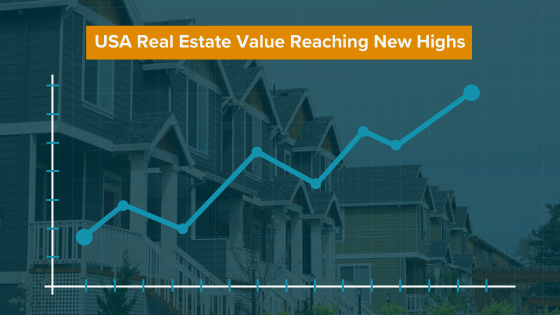


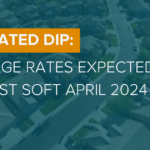


0 Comments